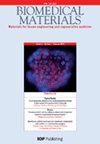High-precision 3D printing of multi-branch vascular scaffold with plasticized PLCL thermoplastic elastomer.
IF 3.9
3区 医学
Q2 ENGINEERING, BIOMEDICAL
引用次数: 0
Abstract
Three-dimensional (3D) printing has emerged as a transformative technology for tissue engineering, enabling the production of structures that closely emulate the intricate architecture and mechanical properties of native biological tissues. However, the fabrication of complex microstructures with high accuracy using biocompatible, degradable thermoplastic elastomers poses significant technical obstacles. This is primarily due to the inherent soft-matter nature of such materials, which complicates real-time control of micro-squeezing, resulting in low fidelity or even failure. In this study, we employ Poly (L-lactide-co-ε-caprolactone) (PLCL) as a model material and introduce a novel framework for high-precision 3D printing based on the material plasticization process. This approach significantly enhances the dynamic responsiveness of the start-stop transition during printing, thereby reducing harmful errors by up to 93%. Leveraging this enhanced material, we have efficiently fabricated arrays of multi-branched vascular scaffolds that exhibit exceptional morphological fidelity and possess elastic moduli that faithfully approximate the physiological modulus spectrum of native blood vessels, ranging from 2.5 to 45 MPa. The methodology we propose for the compatibilization and modification of elastomeric materials addresses the challenge of real-time precision control, representing a significant advancement in the domain of melt polymer 3D printing. This innovation holds considerable promise for the creation of detailed multi-branch vascular scaffolds and other sophisticated organotypic structures critical to advancing tissue engineering and regenerative medicine. .使用塑化 PLCL 热塑性弹性体高精度 3D 打印多分支血管支架。
三维(3D)打印技术已成为组织工程领域的一项变革性技术,它能够制造出近似于原生生物组织复杂结构和机械性能的结构。然而,使用生物相容性好、可降解的热塑性弹性体制造高精度的复杂微结构却面临着巨大的技术障碍。这主要是由于此类材料固有的软物质特性,使得微挤压的实时控制变得复杂,从而导致保真度低甚至失效。在本研究中,我们采用聚(L-内酯-共-ε-己内酯)(PCLL)作为模型材料,并基于材料塑化过程引入了一种新的高精度三维打印框架。这种方法大大增强了打印过程中启动-停止转换的动态响应能力,从而将有害误差减少了 93%。利用这种增强型材料,我们高效地制造出了多分支血管支架阵列,其形态保真度极高,弹性模量忠实地接近于原生血管的生理模量谱,范围在 2.5 到 45 兆帕之间。我们提出的弹性材料相容和改性方法解决了实时精确控制的难题,是熔融聚合物三维打印领域的一大进步。这项创新为创建精细的多分支血管支架和其他复杂的器官型结构带来了巨大希望,对推进组织工程和再生医学的发展至关重要。.
本文章由计算机程序翻译,如有差异,请以英文原文为准。
求助全文
约1分钟内获得全文
求助全文
来源期刊

Biomedical materials
工程技术-材料科学:生物材料
CiteScore
6.70
自引率
7.50%
发文量
294
审稿时长
3 months
期刊介绍:
The goal of the journal is to publish original research findings and critical reviews that contribute to our knowledge about the composition, properties, and performance of materials for all applications relevant to human healthcare.
Typical areas of interest include (but are not limited to):
-Synthesis/characterization of biomedical materials-
Nature-inspired synthesis/biomineralization of biomedical materials-
In vitro/in vivo performance of biomedical materials-
Biofabrication technologies/applications: 3D bioprinting, bioink development, bioassembly & biopatterning-
Microfluidic systems (including disease models): fabrication, testing & translational applications-
Tissue engineering/regenerative medicine-
Interaction of molecules/cells with materials-
Effects of biomaterials on stem cell behaviour-
Growth factors/genes/cells incorporated into biomedical materials-
Biophysical cues/biocompatibility pathways in biomedical materials performance-
Clinical applications of biomedical materials for cell therapies in disease (cancer etc)-
Nanomedicine, nanotoxicology and nanopathology-
Pharmacokinetic considerations in drug delivery systems-
Risks of contrast media in imaging systems-
Biosafety aspects of gene delivery agents-
Preclinical and clinical performance of implantable biomedical materials-
Translational and regulatory matters
文献相关原料
| 公司名称 | 产品信息 | 采购帮参考价格 |
|---|
 求助内容:
求助内容: 应助结果提醒方式:
应助结果提醒方式:


